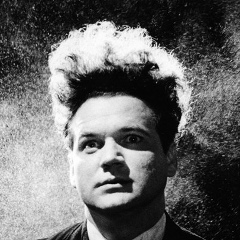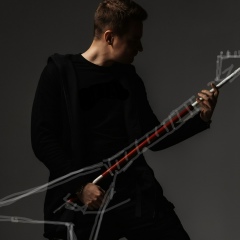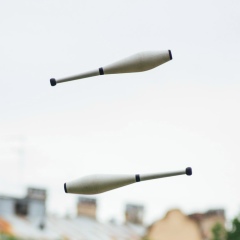О зрительной коре или "И все осветилось"
Около недели назад я побывал на крутой школе, организованной институтом Аллана под названием Dynamic Brain. Сама школа проходила на острове San Juan в бухте тихого океана недалеко от Сиэтла, где этот самый институт и находится. По острову ходят олени, бегают куропатки, на побережье можно найти тюленей и выдр, а далеко в море иногда видно касаток и китов. Место совершенно идиллическое, по ночам можно посмотреть на флюоресцентное море, в котором много планктона и медуз, в которых много зеленого флюоресцентного белка, GFP (https://en.wikipedia.org/wiki/Green_fluorescent_protein).
От того море постоянно светится по ночам, особенно если провести по нему веслом. При чем тут GFP и нейробиология станет чуть позже. Молекулярная скульптура именно этого белка как раз находится справа от меня. Более того, именно в Friday Harbor Labs он как раз был выделен в том числе Осаму Шимомурой (https://en.wikipedia.org/wiki/Osamu_Shimomura). За это им вместе с другими авторами он получил Нобелевскую премию по химии в 2008 году.
Занимались на этой школе мы разными проектами от коннектомики (построение связей мозга), классификацией типов клеток на основании об экспресии генов и электрофизиологии, а также анализом активности зрительной коры во время зрения (неизбежная тавтология).
Поскольку у меня есть предвзятой отношение, что динамика в мозге - самое главное и интересное (даже школа называется Dynamic Brain), в проекте мы анализировали активность первичной зрительной коры. Представьте себе мышь, у которой зафиксирована голова, но которая тем не менее способна бегать по диску. В это время на большом экране показывают различные стимулы, как простые вроде движущихся полосок наподобие зебры, таки и более сложные вроде фотографий или фрагментов фильмов "Печать зла" (https://en.wikipedia.org/wiki/Touch_of_Evil). Благодаря тому, что мыши трансгенные, в их нейронах есть GFP белок (тот самый, который светится в планктоне и медузах). Этот белок вместе с кальциевым сенсором вставлен туда с помощью вектора GCamp (https://en.wikipedia.org/wiki/GCaMP). Таким образом, нейрон начинает сильно светиться каждый раз, когда отдельная клетка генерирует спайк. Именно это и являлось отправной точкой для нашего анализа данных (http://observatory.brain-map.org/visualcoding).
Иными словами живая мышь смотрит на полоски, а в это время у нее в первичной зрительной коре зажигаются нейроны и мы с помощью микроскопа можем наблюдать около 300 клеток одновременно. Затем мы пытаемся понять что же видит наша мышь только на основании активности нейронов. Это похоже на попытку понять о чем фильм, если доступен не весь экран, а только маленький кусочек размером в несколько пикселей.
Тем не менее эту задачу возможно решить, если предварительно извлечь информацию о спайках из отдельных клеток на основании записей активности кальция (помним, что в нейронах GCamp). Затем необходимо построить модель, которую мы будем сначала тренировать на данных активности, а затем проверять с помощью предсказания на таких же. Поскольку декодирование активности нейронов в случае сложного стимула вроде видео или фотографий дело непростое, а времени на проект у нас было мало, мы использовали простой стимул в виде чередующихся полосок, которые движутся по 8 разным направлениям. Задачей декодера в таком случае является определение направление стимула только на основании нервной активности. Более конкретно мы использовали метод опорных векторов, support vector machine (https://en.wikipedia.org/wiki/Support_vector_machine). Название у этого метода забавное, у меня первая ассоциация, self-transforming elf machine (http://non-aliencreatures.wikia.com/wiki/Machine_Elf).
В двух словах про метод опорных векторов. Представьте, что вы насыпали подсолнечные и тыквенные семечки на стол, но не слишком хорошо их перемешали. Затем вам нужно так разделить стол, двумя линиями, чтобы максимально разделить одни семечки от других. Стимулом в данном случае являются разные виды семечек. Затем, представьте, что вы записываете активность из двух нейронов, например, считаете количество спайков по осям. При этом, если активность разная для двух видов стимула, то их можно разделить. Затем тоже самое нужно представить, если направлений 8, т. е. размерность 8 и нейронов у вас не два, а 300, тогда будет похоже на SVM, который мы использовали.
Так вот, с помощью SVM, у нас получилось декодировать направление стимула на основании активности нейронов зрительной коры! При этом SVM, построенная на спайках оказалось лучше на 10%, чем построенная только на кальциевой активности. Иными словами, с помощью алгоритма по сортировке спайков нам удалось отделить зерна от плевел, т. е. спайки от шума и показать, что такое декодирование эффективнее, 70% против 60%. Не самый большой результат за одну неделю, но сам факт того, что удалось выделить спайки и, по всей видимости неплохо, позволит использовать их для дальнейшего анализ паттернов активности сети, чтобы лучше понять какие именно характеристики (features) вычисляются в зрительной коре.
Коротко на английском об этой школе почитать можно здесь:
http://www.buchin.info/single-post/2016/09/04/Dynamic-Brain-workshop-by-Allen-Institute
http://compneuro.washington.edu/the-dyn
Около недели назад я побывал на крутой школе, организованной институтом Аллана под названием Dynamic Brain. Сама школа проходила на острове San Juan в бухте тихого океана недалеко от Сиэтла, где этот самый институт и находится. По острову ходят олени, бегают куропатки, на побережье можно найти тюленей и выдр, а далеко в море иногда видно касаток и китов. Место совершенно идиллическое, по ночам можно посмотреть на флюоресцентное море, в котором много планктона и медуз, в которых много зеленого флюоресцентного белка, GFP (https://en.wikipedia.org/wiki/Green_fluorescent_protein).
От того море постоянно светится по ночам, особенно если провести по нему веслом. При чем тут GFP и нейробиология станет чуть позже. Молекулярная скульптура именно этого белка как раз находится справа от меня. Более того, именно в Friday Harbor Labs он как раз был выделен в том числе Осаму Шимомурой (https://en.wikipedia.org/wiki/Osamu_Shimomura). За это им вместе с другими авторами он получил Нобелевскую премию по химии в 2008 году.
Занимались на этой школе мы разными проектами от коннектомики (построение связей мозга), классификацией типов клеток на основании об экспресии генов и электрофизиологии, а также анализом активности зрительной коры во время зрения (неизбежная тавтология).
Поскольку у меня есть предвзятой отношение, что динамика в мозге - самое главное и интересное (даже школа называется Dynamic Brain), в проекте мы анализировали активность первичной зрительной коры. Представьте себе мышь, у которой зафиксирована голова, но которая тем не менее способна бегать по диску. В это время на большом экране показывают различные стимулы, как простые вроде движущихся полосок наподобие зебры, таки и более сложные вроде фотографий или фрагментов фильмов "Печать зла" (https://en.wikipedia.org/wiki/Touch_of_Evil). Благодаря тому, что мыши трансгенные, в их нейронах есть GFP белок (тот самый, который светится в планктоне и медузах). Этот белок вместе с кальциевым сенсором вставлен туда с помощью вектора GCamp (https://en.wikipedia.org/wiki/GCaMP). Таким образом, нейрон начинает сильно светиться каждый раз, когда отдельная клетка генерирует спайк. Именно это и являлось отправной точкой для нашего анализа данных (http://observatory.brain-map.org/visualcoding).
Иными словами живая мышь смотрит на полоски, а в это время у нее в первичной зрительной коре зажигаются нейроны и мы с помощью микроскопа можем наблюдать около 300 клеток одновременно. Затем мы пытаемся понять что же видит наша мышь только на основании активности нейронов. Это похоже на попытку понять о чем фильм, если доступен не весь экран, а только маленький кусочек размером в несколько пикселей.
Тем не менее эту задачу возможно решить, если предварительно извлечь информацию о спайках из отдельных клеток на основании записей активности кальция (помним, что в нейронах GCamp). Затем необходимо построить модель, которую мы будем сначала тренировать на данных активности, а затем проверять с помощью предсказания на таких же. Поскольку декодирование активности нейронов в случае сложного стимула вроде видео или фотографий дело непростое, а времени на проект у нас было мало, мы использовали простой стимул в виде чередующихся полосок, которые движутся по 8 разным направлениям. Задачей декодера в таком случае является определение направление стимула только на основании нервной активности. Более конкретно мы использовали метод опорных векторов, support vector machine (https://en.wikipedia.org/wiki/Support_vector_machine). Название у этого метода забавное, у меня первая ассоциация, self-transforming elf machine (http://non-aliencreatures.wikia.com/wiki/Machine_Elf).
В двух словах про метод опорных векторов. Представьте, что вы насыпали подсолнечные и тыквенные семечки на стол, но не слишком хорошо их перемешали. Затем вам нужно так разделить стол, двумя линиями, чтобы максимально разделить одни семечки от других. Стимулом в данном случае являются разные виды семечек. Затем, представьте, что вы записываете активность из двух нейронов, например, считаете количество спайков по осям. При этом, если активность разная для двух видов стимула, то их можно разделить. Затем тоже самое нужно представить, если направлений 8, т. е. размерность 8 и нейронов у вас не два, а 300, тогда будет похоже на SVM, который мы использовали.
Так вот, с помощью SVM, у нас получилось декодировать направление стимула на основании активности нейронов зрительной коры! При этом SVM, построенная на спайках оказалось лучше на 10%, чем построенная только на кальциевой активности. Иными словами, с помощью алгоритма по сортировке спайков нам удалось отделить зерна от плевел, т. е. спайки от шума и показать, что такое декодирование эффективнее, 70% против 60%. Не самый большой результат за одну неделю, но сам факт того, что удалось выделить спайки и, по всей видимости неплохо, позволит использовать их для дальнейшего анализ паттернов активности сети, чтобы лучше понять какие именно характеристики (features) вычисляются в зрительной коре.
Коротко на английском об этой школе почитать можно здесь:
http://www.buchin.info/single-post/2016/09/04/Dynamic-Brain-workshop-by-Allen-Institute
http://compneuro.washington.edu/the-dyn
About the visual cortex or "And it all lit up"
About a week ago, I visited a cool school organized by the Allan Institute called Dynamic Brain. The school itself was held on the island of San Juan in the bay of the Pacific Ocean near Seattle, where this very institute is located. Deer walk around the island, partridges run, seals and otters can be found on the coast, and killer whales and whales can sometimes be seen far into the sea. The place is completely idyllic, at night you can look at the fluorescent sea, in which there are a lot of plankton and jellyfish, in which there is a lot of green fluorescent protein, GFP (https://en.wikipedia.org/wiki/Green_fluorescent_protein).
From that, the sea constantly glows at night, especially if you hold an oar on it. What does GFP and neurobiology have to do with it a bit later. The molecular sculpture of this particular protein is just to my right. Moreover, it was at Friday Harbor Labs that he was singled out including Osamu Shimomura (https://en.wikipedia.org/wiki/Osamu_Shimomura). For this, he, along with other authors, he received the Nobel Prize in Chemistry in 2008.
At this school, we were engaged in various projects from connectivity (building brain connections), the classification of cell types based on gene expression and electrophysiology, and the analysis of the activity of the visual cortex during vision (inevitable tautology).
Since I have a biased attitude that the dynamics in the brain are the most important and interesting (even the school is called Dynamic Brain), in the project we analyzed the activity of the primary visual cortex. Imagine a mouse that has a fixed head, but which is nonetheless capable of running around the disk. At this time, various incentives are shown on the big screen, such as simple ones like moving strips like a zebra, and more complex ones like photos or fragments of the films “Seal of Evil” (https://en.wikipedia.org/wiki/Touch_of_Evil). Due to the fact that mice are transgenic, in their neurons there is a GFP protein (the same one that glows in plankton and jellyfish). This protein, together with the calcium sensor, was inserted there using the GCamp vector (https://en.wikipedia.org/wiki/GCaMP). Thus, the neuron begins to glow strongly every time a single cell generates a spike. This is precisely the starting point for our data analysis (http://observatory.brain-map.org/visualcoding).
In other words, a live mouse looks at the strips, and at this time, neurons are lit in its primary visual cortex and we can observe about 300 cells with a microscope at a time. Then we try to understand what our mouse sees only on the basis of the activity of neurons. This is similar to trying to understand what the film is about, if not the entire screen is available, but only a small piece a few pixels in size.
Nevertheless, this problem can be solved by first extracting information about spikes from individual cells based on calcium activity records (remember that in GCamp neurons). Then it is necessary to build a model, which we will first train on activity data, and then test using predictions on the same. Since decoding the activity of neurons in the case of a complex stimulus such as video or photographs is not easy, and we had little time for the project, we used a simple stimulus in the form of alternating stripes that move in 8 different directions. The task of the decoder in this case is to determine the direction of the stimulus only on the basis of nervous activity. More specifically, we used the support vector machine method, support vector machine (https://en.wikipedia.org/wiki/Support_vector_machine). The name of this method is funny, I have the first association, self-transforming elf machine (http://non-aliencreatures.wikia.com/wiki/Machine_Elf).
In a nutshell about the support vector method. Imagine that you poured sunflower and pumpkin seeds on the table, but did not mix them too well. Then you need to divide the table in two lines so as to maximize the separation of some seeds from others. The stimulus in this case is different types of seeds. Then, imagine that you are recording activity from two neurons, for example, you count the number of spikes along the axes. Moreover, if the activity is different for the two types of stimulus, then they can be divided. Then the same thing needs to be imagined, if there are 8 directions, i.e., the dimension of 8 and the neurons are not two, but 300, then it will look like the SVM we used.
So, with the help of SVM, we managed to decode the direction of the stimulus based on the activity of neurons in the visual cortex! At the same time, SVM built on spikes turned out to be 10% better than built only on calcium activity. In other words, using the spike sorting algorithm, we were able to separate the grains from the chaff, that is, spikes from noise and show that such decoding is more efficient, 70% versus 60%. Not the biggest result in one week, but the very fact that it was possible to isolate spikes and, apparently, not bad, will allow using them for further analysis of network activity patterns in order to better understand which x
About a week ago, I visited a cool school organized by the Allan Institute called Dynamic Brain. The school itself was held on the island of San Juan in the bay of the Pacific Ocean near Seattle, where this very institute is located. Deer walk around the island, partridges run, seals and otters can be found on the coast, and killer whales and whales can sometimes be seen far into the sea. The place is completely idyllic, at night you can look at the fluorescent sea, in which there are a lot of plankton and jellyfish, in which there is a lot of green fluorescent protein, GFP (https://en.wikipedia.org/wiki/Green_fluorescent_protein).
From that, the sea constantly glows at night, especially if you hold an oar on it. What does GFP and neurobiology have to do with it a bit later. The molecular sculpture of this particular protein is just to my right. Moreover, it was at Friday Harbor Labs that he was singled out including Osamu Shimomura (https://en.wikipedia.org/wiki/Osamu_Shimomura). For this, he, along with other authors, he received the Nobel Prize in Chemistry in 2008.
At this school, we were engaged in various projects from connectivity (building brain connections), the classification of cell types based on gene expression and electrophysiology, and the analysis of the activity of the visual cortex during vision (inevitable tautology).
Since I have a biased attitude that the dynamics in the brain are the most important and interesting (even the school is called Dynamic Brain), in the project we analyzed the activity of the primary visual cortex. Imagine a mouse that has a fixed head, but which is nonetheless capable of running around the disk. At this time, various incentives are shown on the big screen, such as simple ones like moving strips like a zebra, and more complex ones like photos or fragments of the films “Seal of Evil” (https://en.wikipedia.org/wiki/Touch_of_Evil). Due to the fact that mice are transgenic, in their neurons there is a GFP protein (the same one that glows in plankton and jellyfish). This protein, together with the calcium sensor, was inserted there using the GCamp vector (https://en.wikipedia.org/wiki/GCaMP). Thus, the neuron begins to glow strongly every time a single cell generates a spike. This is precisely the starting point for our data analysis (http://observatory.brain-map.org/visualcoding).
In other words, a live mouse looks at the strips, and at this time, neurons are lit in its primary visual cortex and we can observe about 300 cells with a microscope at a time. Then we try to understand what our mouse sees only on the basis of the activity of neurons. This is similar to trying to understand what the film is about, if not the entire screen is available, but only a small piece a few pixels in size.
Nevertheless, this problem can be solved by first extracting information about spikes from individual cells based on calcium activity records (remember that in GCamp neurons). Then it is necessary to build a model, which we will first train on activity data, and then test using predictions on the same. Since decoding the activity of neurons in the case of a complex stimulus such as video or photographs is not easy, and we had little time for the project, we used a simple stimulus in the form of alternating stripes that move in 8 different directions. The task of the decoder in this case is to determine the direction of the stimulus only on the basis of nervous activity. More specifically, we used the support vector machine method, support vector machine (https://en.wikipedia.org/wiki/Support_vector_machine). The name of this method is funny, I have the first association, self-transforming elf machine (http://non-aliencreatures.wikia.com/wiki/Machine_Elf).
In a nutshell about the support vector method. Imagine that you poured sunflower and pumpkin seeds on the table, but did not mix them too well. Then you need to divide the table in two lines so as to maximize the separation of some seeds from others. The stimulus in this case is different types of seeds. Then, imagine that you are recording activity from two neurons, for example, you count the number of spikes along the axes. Moreover, if the activity is different for the two types of stimulus, then they can be divided. Then the same thing needs to be imagined, if there are 8 directions, i.e., the dimension of 8 and the neurons are not two, but 300, then it will look like the SVM we used.
So, with the help of SVM, we managed to decode the direction of the stimulus based on the activity of neurons in the visual cortex! At the same time, SVM built on spikes turned out to be 10% better than built only on calcium activity. In other words, using the spike sorting algorithm, we were able to separate the grains from the chaff, that is, spikes from noise and show that such decoding is more efficient, 70% versus 60%. Not the biggest result in one week, but the very fact that it was possible to isolate spikes and, apparently, not bad, will allow using them for further analysis of network activity patterns in order to better understand which x





У записи 21 лайков,
2 репостов.
2 репостов.
Эту запись оставил(а) на своей стене Анатолий Бучин








































